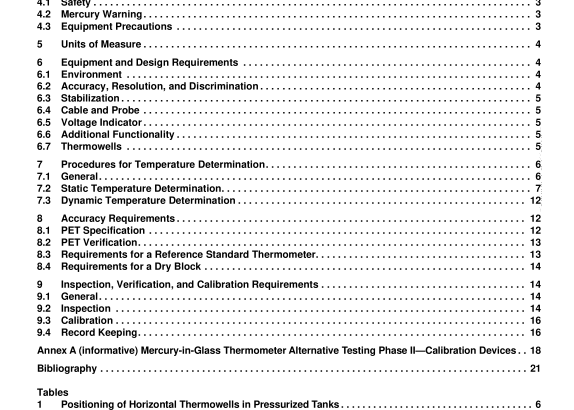API MPMS 7.2:2018 pdf free download.Manual of Petroleum Measurement Standards Chapter 7—Temperature Determination Section 2—Portable Electronic Thermometers
4 General Precautions
4.1 Safety Safety shall be considered for the specification, installation, and operation of all equipment. Refer to API RP 500 and NFPA 70 for guidance. When loading liquids that can accumulate static charges, refer to the precautions described in the International Safety Guide for Oil Tankers and Terminals, Safety of Life at Sea (ISGOTT), API MPMS Ch. 3, and API RP 2003. Safety and material compatibility precautions should be taken into consideration when using PETs. The manufacturer recommendations on the use of the equipment should be followed. Users of PETs should comply with all applicable codes, regulations, API standards, and the applicable national electrical safety standards (e.g. NFPA 70 in the U.S.). A
ll PETs used in marine service should be specified in accordance with the appropriate national or international (IMO, USCG, IEC, ISGOTT, ISO, etc.) marine electrical safety standards. PETs shall be certified for use in the hazardous area classification appropriate to their use.
4.2 Mercury Warning Warning—Mercury has been designated by the EPA and many state agencies as a hazardous material that can cause central nervous system, kidney, and liver damage. Mercury, or its vapor, may be hazardous to health and corrosive to materials. Caution should be taken when handling mercury and products that contain mercury. See the applicable product safety data sheet (SDS) for details and the EPA website (www.epa.gov/mercury/faq.htm) for additional information. Users should be aware that selling mercury or products that contain mercury may be prohibited by state law.
4.3 Equipment Precautions The following general precautions affect the accuracy and performance of all types of PETs. These precautions should be observed where they are applicable. All PETs should be capable of withstanding the temperature and other environmental conditions likely to be encountered in the designated service.
When a PET is used in a corrosive service, any parts exposed to the liquid or vapor should be of durable, corrosion-resistant construction to avoid both product contamination and PET corrosion. PETs used in marine or onshore tank applications with an inert gas system (IGS) or blanket gas system should be designed to withstand the operating pressure of the gas. Consult the PET manufacturer recommendation. The operational range limits, as well as the ambient impact on the measurement accuracy of all equipment as part of a temperature measurement system, shall be clearly stated and provided by the equipment manufacturer.
The design and use of PETs may be subject to the approval of the national measurement organization or classification societies, who may have issued an approval for the design of the PET for the particular service for which it is to be employed. Type or pattern approval is normally issued after a PET has been subjected to a specific series of tests and is subject to the PET being used in an approved manner.
5 Units of Measure
For custody transfer, the means of temperature determination should be agreed to among the parties involved. Temperatures referenced in this document are those defined by the International Temperature Scale of 1990 (ITS-90). Temperatures may be measured and expressed in degrees Celsius or in degrees Fahrenheit. This standard presents both SI and USC units, and either may be implemented.
The presentations of both units are for the convenience of the user, and are not necessarily exact conversions. The units of implementation are typically determined by contract, regulatory requirement, the manufacturer, or the user calibration program. Once a system of units is chosen for a given application, they should not be arbitrarily changed. (See API MPMS Ch. 15.)
6 Equipment and Design
Requirements A wide range of portable electronic thermometers are available that are designed to take spot temperatures at any location within a tank that is accessible from the available gauging access point(s). The PET may be used as a precise measuring device for measuring the temperature of petroleum or petroleum product. It may also be used as reference thermometer for verifying the calibration of other (permanently installed) temperature-measuring devices.API MPMS 7.2 pdf download.API MPMS 7.2:2018 pdf free download
